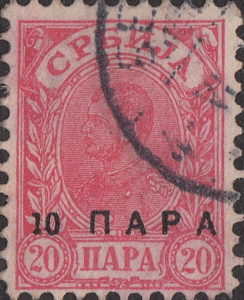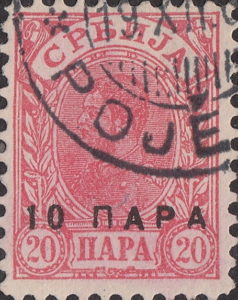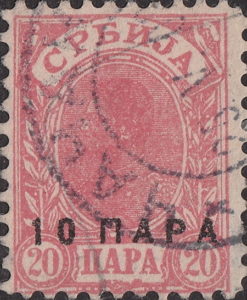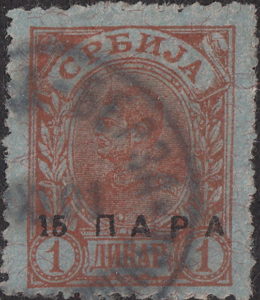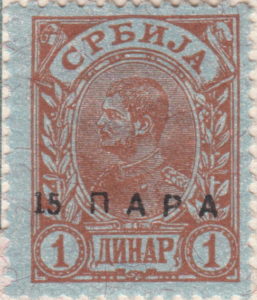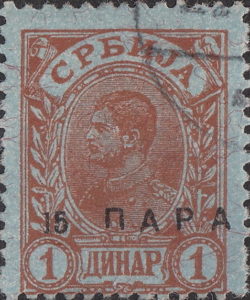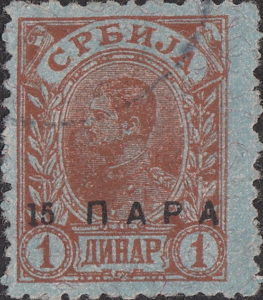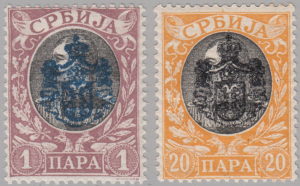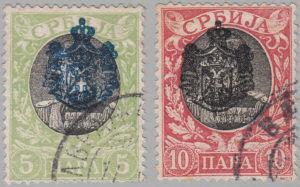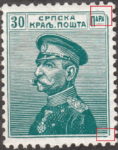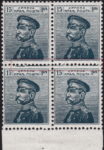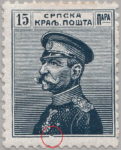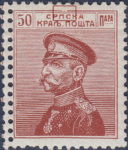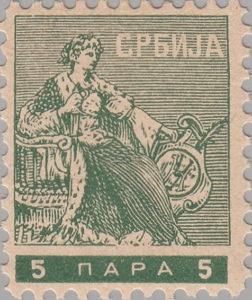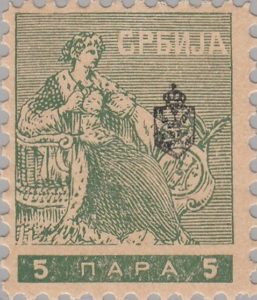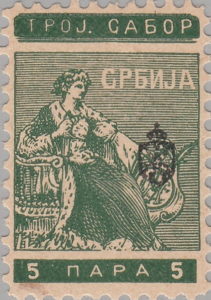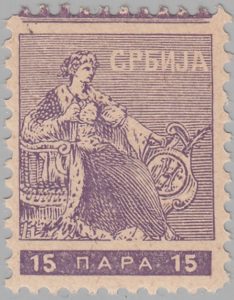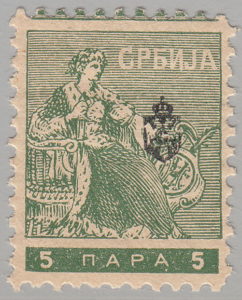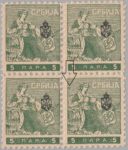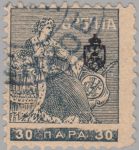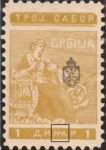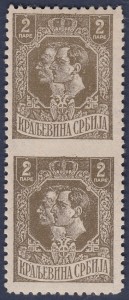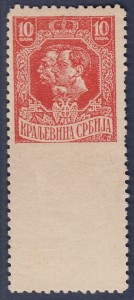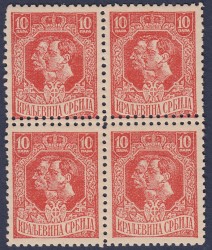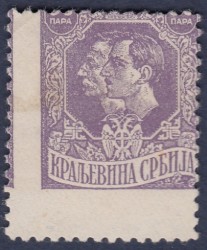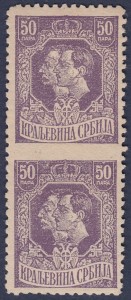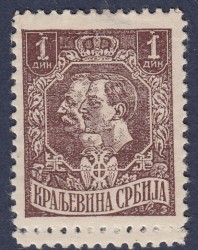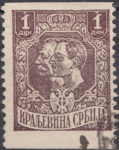The Kingdom of Serbia
1896-1902. The Second Definitive Issue of the King Alexander Stamps
| CONSTANT VARIETIES | |||
|---|---|---|---|
| 1 para, brick red | |||
| I | 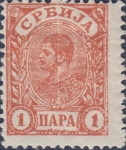 |
Oval with King’s effigy vertically split in the middle. | |
| Field №: ? | Pane: N/A | ||
| Other nomenclatures: – | |||
| Notes: another example. | |||
| Value €: – | |||
| 5 para, green | |||
| I | 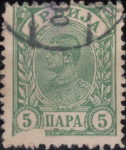 |
Damaged cliche at the bottom left corner (the 1898 issue on plain white paper). | |
| Field №: 91 (1st printing), 95 (2nd printing) | Pane: N/A | ||
| Other nomenclatures: – | |||
| Notes: – | |||
| Value €: – | |||
| 10 para, rose | |||
| I | 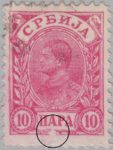 |
White spot below the first letter A in ПАРА (the 1898 issue on plain white paper). | |
| Field №: ? | Pane: N/A | ||
| Other nomenclatures: – | |||
| Notes: – | |||
| Value €: – | |||
| PERFORATIONS | ||
|---|---|---|
| 1 para, brick red | ||
| I | 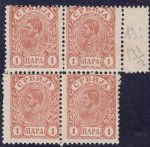 |
Combined perforation: 13: 13 ½ |
1900/1902. The first provisional issues.
The 10 para stamp was used for ordinary letters and was therefore among most frequently used denominations. When the stock ran out a reprint of this denomination was not possible due to worn cliches. It was therefore decided to reprint the 20 para stamps in rose color of 10 para stamp and overprint them with black overprint in letterpress.
There are three types of overprints of 10 para stamp and four types of overprints of 15 para stamp. Types I and II of 10 para stamps belong to the same printing as damaged Type I cliches were replaced by Type II. Type III was issued in early 1902. All four types of 15 para stamp belong to the same printing as they can all be found in a single sheet of 100.
| ISSUES BY TYPES AND PERFORATIONS | ||||
|---|---|---|---|---|
| 10 ПАРА on 20 ПАРА, rose | ||||
| Type | Date of issue | Comb 13 x 13½ | Comb 13 x 13½, bottom line 11½ | Line 11½ |
| I | 1 November 1900 | x | x | x |
| II | November (?) 1901 | x | x | x |
| III | early 1902 | x | ||
| 15 ПАРА on 1 ДИНАР, red brown on blue paper | ||||
| I-IV | 16 October 1901 | x | ||
King Alexander Issue of 1901-1903
Printed in Belgrade State Printers (Državna štamparija) in letterpress. Paper regular, perforation line 11½.
| COINCIDENTAL VARIETIES | ||
|---|---|---|
| 5 para | ||
| 1 | Color spill. | 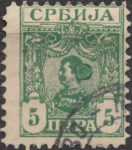 |
1903/04. Definitive issue (provisional), effigy of King Alexander Obrenović overprinted with coat of arms.
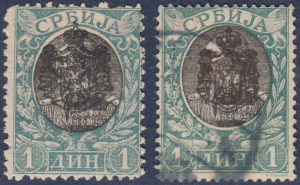 |
| Apart from being perforated line 11½, the 1 dinar stamp of the 1904 Belgrade print has large coat of arms overprint. |
In the coup of 1903 King Alexander and Queen Draga were assassinated by a group of officers. At that time the new stamps, designed by E. Mouchon were already printed in Paris. At the time when the stamps had to be delivered, the printing of 3 and 5 din stamps was not finished yet. State Printing Works in Belgrade received these stamps imperforate and smaller part without gum. These values were finazlied in Belgrade where white gum (instead of yellowish as in Paris print) was applied and stamps were perforated line 11½. The stamps were then overprinted in by the Royal Coat of Arms in two types of overprints:
- the 12 mm wide and 15 mm high overprint was used for para values, and
- the 10 mm wide and 14 mm high overprint for dinar values.
Overprinting was first done in lithography but that method was abandoned as the sheets stated to curl and glue together. The remaining stamps were then overprinted in letterpress. The entire stock of 1 and 20 para stamps were overprinted in lithography, other para values in both lithography and letterpress and dinar values in letterpress only. Stamps were released on 25 June 1903 other issues bearing a portrait of the unpopular late king were demonetized by the Provisional Government.
On 10 July 1904 three values, 5 para, 50 para and 1 din were reprinted by State Printing Works in Belgrade. The Belgrade printing differs from the Paris print by line 11½ perforation.
| COINCIDENTAL VARIETIES | ||
|---|---|---|
| 1 | Partially perforated. | 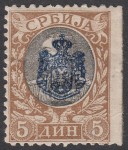 |
The Coronation Issue
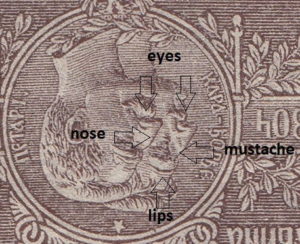 |
| “The death mask of Aleksandar”, the hidden design. |
A special set of stamps, commemorating the crowning of King Peter I Karađorđević and the centenary of the first Serbian uprising under Đorđe Petrović – Karađorđe (the King’s grandfather) was issued on the day of the coronation, 8 September 1904.
Stamps were printed by Belgrade State Printers (Državna štamparija) in letterpress on thin, smooth, transparent paper. Perforation line 11½. The sheets consisted of 100 stamps, divided by a vertical and horizontal gutter, dividing the sheet in 4 panes of 25 stamps each. Gutters between denominations were of different height, for this reason sheets are of different sizes.
Contemporary philatelists noticed that when the stamps with portraits are turned upside down a ghostly face may be seen in the space where the two heads overlap. Many stamp collectors believe this is the death mask of Aleksandar I Obrenović, the assassinated king. The coincidence has been attributed to macabre humor of Mr. Đorđe Jovanović, the designer.
| FORGERIES | ||
|---|---|---|
| All denominations | ||
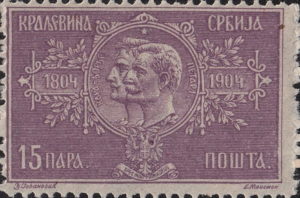 |
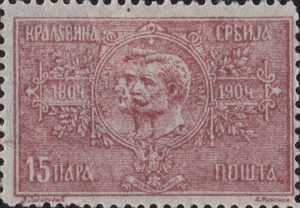 |
Forgeries:
|
| Genuine stamp | Forgery | |
| More examples (original on top, forgery below): 5 para, 10 para, 15 para, 25 para, 50 para, 1 dinar. | ||
| COINCIDENTAL VARIETIES | ||
|---|---|---|
| 1 | Partly imperforate. | 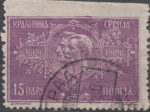  |
Definitive Issue “King Peter Bareheaded”
Stamps were printed by Belgrade State Printers (Državna štamparija) in letterpress in two operations: the frames in different colors were done first then the medallion in black. Stamps were printed in sheets of 100 which were separated by a horizontal gutter to forms 2 panes of 50 stamps.
During the almost 7 years these stamps were in use, they were reprinted several times. Printings can be differed by types of papers, perforations and widths of horizontal gutters. It has to be mentioned that a small quantity of 5 para stamp of the first printing was comb perforated 12 x 11½ and a small quantity of 1 para and 1 dinar stamp of the second printing line perforated 11½.
| PRINTINGS | 1st Jan.1905 |
2nd Oct.1905 |
3rd 1905 |
4th 1908 |
5th 1910 |
6th 1911 |
|
|---|---|---|---|---|---|---|---|
| Paper: | thin | thick wove, pre gummed | soft porous | thick, horizontally laid | smooth, slightly transparent, medium thick | thick, vertically laid | |
| Perforation: | line 11½ | comb 12 x 11½ | |||||
| Appearance: | – | – | dark colors | – | design blurred | – | |
| Denomination | Quantity printed | ||||||
| 1 para | 7.160.300 | x | x | – | x | x | x |
| 5 para | 28.404.200 | x | x | – | x | x | x |
| 10 para | 26.147.800 | x | x | – | x | x | x |
| 15 para | 2.409.100 | x | x | x | x | x | – |
| 20 para | 2.968.000 | x | x | x | x | x | – |
| 25 para | 4.721.800 | x | x | x | x | x | – |
| 30 para | 2.463.000 | x | x | – | x | x | x |
| 50 para | 3.244.800 | x | x | x | x | x | – |
| 1 din | 857.600 | x | x | – | – | – | – |
| 3 din | 117.400 | x | x | – | – | – | – |
| 5 din | 146.200 | x | x | – | – | – | – |
| FORGERIES | ||
|---|---|---|
| All denominations | ||
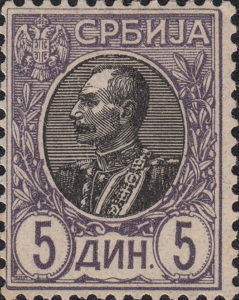 |
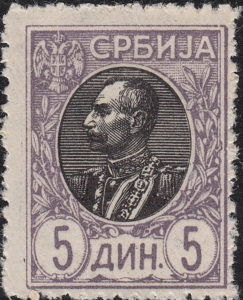 |
Forgeries:
|
| Genuine stamp | Forgery | |
| More examples (left stamp is genuine): 1 para, 5 para, 10 para, 15 para, 20 para, 25 para, 30 para, 50 para, 1 dinar, 3 dinara, 5 din. | ||
King Peter with Cap Issues.
The stamps were designed by Miodrag Marković, modeled after a photograph of King Peter of Serbia. Stamps were printed by Belgrade State Printers in typography on medium thick chalk surfaced paper in sheets of 100, divided in two panes having 50 stamps each (5X10). The panes were divided by horizontal gutter in height of a stamp. Perforation comb 12 x 11½.
The 5, 10 and 25 para stamps were issued on 11 June 1911, the 1 para in August, the 2 para in September, the 15 para in October, the 20 para in November, the 30 and 50 para and dinar values were issued on 26 December 1911.
Due to reports of allegedly forged 20 para stamp at the end of 1913 the Minister in charge ordered demonetization of the 1911 issue as of 28 January 1914 and printing of a new issue in all values from the 5 para up, using the old cliches and new colors. The same paper as before was used, the same layout of the sheet, the same perforation. Due to the outbreak of World War I, the issue of 1914 was never achieved, especially the 3 dinara stamp of which only 7.000 copies were completed.
During the war original cliches were stolen and still exist somewhere in private hands. Using these cliches excellent forgeries of all values were produced, perforated and imperforate, also in different colors. Forgeries were most probably produced in many runs over the years.
| FORGERIES | |
|---|---|
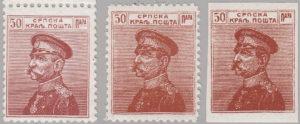 |
The forgeries, produced from original cliches are in every way similar to original stamps. They have similar appearance, they are printed in the same technique on similar chalky paper and having the same perforation as the originals. They are very dangerous, especially when mixed up with original stamps. There are, however, several indices that make forgeries stand out:
Forgeries can also be distinguished by minor flaws in plates (numeral 5 on 5 dinar forgery is damaged, enclosed boxes with inscription ПАРА, damaged upper right frame on 1 dinar stamps, etc). |
| Genuine stamp (left) and perforated and imperforate forgeries. | |
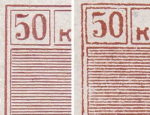 |
|
| Detail: precision of printing (original on the left side). | |
| More examples (the first stamp from the left is original): 1911 issues: 1 para, 2 pare, 10 para, 15 para, 25 para, 30 para, 1 dinar, 3 dinara 1914 issues: 5 para, 10 para, 15 para, 20 para, 25 para, 30 para, 50 para, 1 dinar, 5 dinara |
|
| POSSIBLE TYPES | ||
|---|---|---|
| 1 | Dark spot on King’s cheek, observed only on 15 para stamps of both issues. | 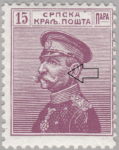 |
| COINCIDENTAL VARIETIES | ||
|---|---|---|
| Perforations | ||
| 1 | Stamps from the first vertical row are often double perforated. |  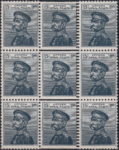 |
| NON-POSTAL USAGE | ||
|---|---|---|
| A | Used as emergency money after WWI in the city of Osijek. Overprinted values in Austro-Hungarian currency: 10, 20, 40 and 50 filler denominations exist. |  |
The Newspaper Stamps of 1911
The stamps were originally issued as labels with purpose of fund raising for the Union of Serbian Journalists. They were sold on Whit Sunday fair (Trojički sabor) between 30. May and 3 June 1908. Values from 1 to 25 para were sold at the price of 5 para each, the 30 para to 5 dinara values at 20 para each. The post office canceled them with a special round postmark that contained the date and inscription Тројички сабор-Београд Ада. Very few labels were sold as collectors showed little interest in them.
The design depicts a seated woman (allegory of Serbia) with a shield with letters CHY (Србско Новинарско Удружење – Union of Serbian Journalists) inscribed on it. Labels were printed for the Union by Belgrade State Printers in typography, perforation 11½. Due to misunderstanding the sheets contained 50 stamps instead of 100 and a second printing was prepared at the insistence of the Union, hence the differences in color. The cliches consisted of 2-3 parts:
- the main cliche depicting the allegory of Serbia was used to print all values,
- the lower cliche to imprint the denominations,
- the upper cliche to imprint inscription ТРОЈ. САБОР on top of the half of the stamps in the first row (fields 6-10).
As the sales at Whit Sunday fair were disappointing the Union leaders attempted to salvage their work by gaining philatelic recognition. By intervention of the Minister of Construction the stamps were made legal for use to frank newspapers at the option of the public. The unsold stock was overprinted with state coat of arms in black color and issued on the 1 December 1911. Only stamps of 1 to 25 para were sold at the main post office and Postal Depot while the entire quantity of 30 para to 5 dinar were kept by the Union. In order to legalize the 30 para to 5 dinar stamps, 25 copies of each were placed in the Postal Depot where they were put on sale. These are the only Serbian stamps not issued for postal use. Stamps of this issue were demonetized on 16 November 1912.
| COINCIDENTAL VARIETIES APPEARING ON ALL VALUES | ||
|---|---|---|
| 1 | Inverted overprint (appears on all values). |  |
| COINCIDENTAL VARIETIES | ||
|---|---|---|
| 5 para | ||
| 1 | Perforation error. | 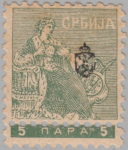 |
| 10 para | ||
| 1 | Horizontally imperforate. | 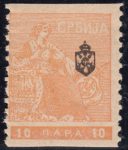 |
| 20 para | ||
| 1 | Wrong cliche inserted in a sheet: 50 para instead of 20 para (stamp in the center), field 27. | 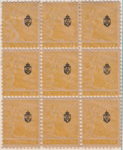 |
Commemorative Issue “King Peter on the Battlefield”
The stamps of this issue commemorate a decisive Serbian victory at the Kolubara river against the invading armies of Austria-Hungary in World War I.
Stamps were designed after a photograph of King Peter observing the battle of Garevica by war photographer V. Černov. The King is sitting on a stone behind trenches, behind him stand Crown Prince Aleksandar, holding a map, Stepan “Stepa” Stepanović, Commander of the Army, holding binoculars and king’s Aide-de-Camp, Lieutenant Colonel Knežević.
Stamps were printed in letterpress by State Printers (Državna štamparija) in Niš, which was then the seat of government. Stamps were printed in sheets of 100 (10×10) on medium thick chalky paper and were line perforated 11½.
Many post offices never received this issue because of the raging war. Only the 5 and 10 para stamps were used, those postmarked “Obrenovac” were canceled for philatelic purposes. Other denominations were used by the local population for small change, which was very scarce. During the war the cliches and unfinished sheets fell into enemy hands, which is how the proofs on medium thick paper came to be prepared in Germany.
| COINCIDENTAL VARIETIES | ||
|---|---|---|
| 1 | Perforation error. | 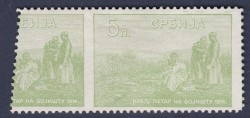 |
| 2 | Horizontally shifted perforation. | 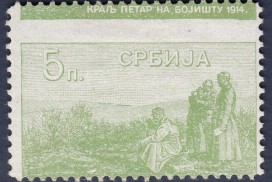 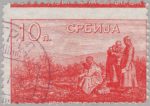 |
| 3 | Double perforation to the left. |  |
| POSSIBLE CONSTANT VARIETIES | ||
|---|---|---|
| 1 | Colored spot below letter С in СРБИЈА. | 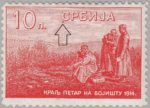 |
The Corfu Issue
During the World War I, the Serbian government moved to Greek island of Corfu where a post office was formed. For private mail French stamps with Serbian postmarks and with occasional POSTES SERBES cancellation were used.
The Paris Print of the Corfu issue
Anticipating the liberation of country the authorities at Corfu ordered a new issue of stamps to be printed in France. The so called “Paris Print of the Corfu issue” appeared in September 1918, while the Serbian government was still on Corfu. Stamps were designed and engraved by Nikola Jeremić with the assistance by Paré, the French engraver and printed in letterpress by State Printing Works in Paris. The stamps were issued on 1 October 1918 but were not sold to the public until June 1919.
Stamps were printed on white medium mesh paper by letterpress in sheets of 100, divided into four panes of 25 stamps in layout of 5 x 5. The 15 para and the dinar values were printed in sheets of 50, divided vertically into two panes of 25. There were perforated rosettes in the bottom margins. Sheets had wide margins and were line perforated 11. The gum is gray.
| PARIS PRINT OF THE CORFU ISSUE | ||
|---|---|---|
| Appearance | clear and clean | |
| Paper | white, medium mesh paper with net structure | |
| Perforation | line 11 | |
| Gum | grayish | |
| Denomination | Color | Quantity printed |
| 1 para | black | 736.000 |
| 2 pare | olive brown | 1.469.000 |
| 5 para | green | 4.048.000 |
| 10 para | red | 4.195.000 |
| 15 para | dark brown | 287.000 |
| 20 para | red brown | 293.000 |
| 25 para | blue | 724.000 |
| 30 para | olive | 731.000 |
| 50 para | violet | 733.000 |
| 1 dinar | chocolate | 44.000 |
| 3 dinara | bluish green | 45.000 |
| 5 dinara | red brown | 43.000 |
| CONSTANT VARIETIES | |||
|---|---|---|---|
| 3 din | |||
| I | 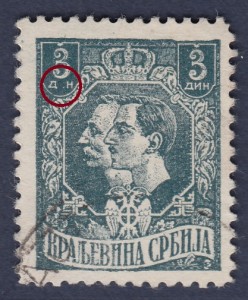 |
Missing letter И in ДИН to the left. | |
| Field №: ? | Pane: N/A | ||
| Other nomenclatures: – | |||
| Notes: – | |||
| Value €: – | |||
| SPECIAL POSTAL USAGE | ||
|---|---|---|
| 1 | Halved stamp, postmark Obrenovac 21.3.1919. Halved stamp, postmark Obrenovac 26.6.1919. |
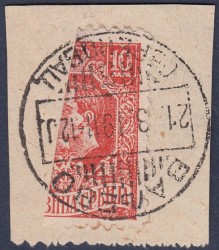 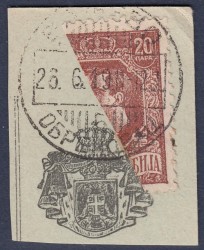 |
The First Belgrade Printing of the Corfu Issue
The so called “First Belgrade Printing of the Corfu Issue” was carried out with the original cliches received from Paris, when the supply of 1, 15, 20 para and 1 dinar stamps ran short. Stamps were printed by Belgrade State Printers (Državna štamparija) in letterpress between 30 September 1919 and 4 January 1920. As there were difficulties with supply of ink the stamps were printed in changed colors. There were 50 stamps in a sheet (10×5). The stamps with para denominations had horizontal control lines in the upper and the lower margin. The 1 dinar stamp had no control lines.
| FIRST BELGRADE PRINTING OF THE CORFU ISSUE | ||
|---|---|---|
| Appearance | blurry, finer details lost | |
| Paper | white, thicker | |
| Perforation | line 11½, very rough | |
| Gum | white | |
| Denomination | Color | Quantity printed |
| 1 para | gray | 60.000 |
| 15 para | dull brown | 53.000 |
| 20 para | violet | 117.000 |
| 1 dinar | yellow brown | 65.000 |
| CONSTANT VARIETIES | |||
|---|---|---|---|
| 1 para | |||
| I | 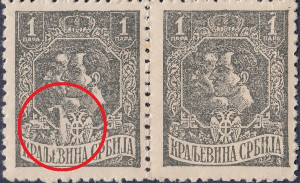 |
White hook. | |
| Field №: 15 | Pane: N/A | ||
| Other nomenclatures: – | |||
| Notes: – | |||
| Value €: – | |||
The Second Belgrade Printing of the Corfu issue
The stamps of the “Second Belgrade Printing of the Corfu issue” was printed several times in 1920. The perforation 11½ is ether rough or clean and sharp. Stamps of the Corfu Issue were in use in Serbia, Montenegro and Macedonia from 1 October 1918 to 15 April 1921. On Corfu they were valid until March 1919.
| SECOND BELGRADE PRINTING OF THE CORFU ISSUE | ||||
|---|---|---|---|---|
| Appearance | blurry, finer details lost | |||
| Perforation | line 11½, either rough or clean and sharp (and combinations) | |||
| Denomination | Color | Quantity printed | Paper | Control lines |
| 1 para | black | 736.000 | very thin pelure | 1st printing: 12 lines 4mm wide on side margins 2nd printing: two 2 mm thick lines on the left and 12 lines 4mm wide on the right |
| 2 pare | yellow brown | 1.469.000 | very thin pelure front back very thin pelure porous paper which is absorbing the gum and makes it look greasy front back |
1st printing: 12 lines 4mm wide on side margins 2nd printing: two 2 mm thick lines on the left and 12 lines 4mm wide on the right |
| 5 para | green | 4.048.000 | thick white, smooth yellowish |
early printings: 12 lines 4mm wide on side margins latter printings: 2 lines 1mm thick on the upper part of the left margin, on the lower part and on the right margin 12 thin lines 4 mm wide |
| 10 para | red | 4.195.000 | thick white, smooth yellowish |
2 lines 1mm thick on the upper part of the left margin, on the lower part and on the right margin 12 thin lines 4 mm wide |
| 15 para | dark brown | 287.000 | thick white, thin porous paper giving oily impression |
stamp on thin paper: single lines on both sides 4 mm thick |
| 20 para | red brown | 293.000 | thick white thin porous giving oily impression |
12 lines 4mm wide on side margins |
| 25 para | blue | 724.000 | thick white thin porous giving oily impression |
Printed 4 times with 3 different types of border lines |
| 30 para | olive | 731.000 | normal thick paper | 1st printing: 12 lines 4mm wide on side margins |
| 50 para | violet | 733.000 | normal thick paper | 1st printing: 12 lines 4mm wide on side margins |
| 1 dinar | chocolate | 44.000 | normal white, smooth yellow |
12 lines 4mm wide on side margins |
| 3 dinara | bluish green | 45.000 | normal white paper | 12 lines 4mm wide on side margins |
| 5 dinara | red brown | 43.000 | smooth yellowish paper | left border line: 12 lines 4mm wide on side margins and two 1 mm lines; on the right border one 3½ mm line. |
| POSSIBLE CONSTANT VARIETIES | ||
|---|---|---|
| 1 para | ||
| 1 | Triangle to the right side close to the frame. |  |
| 50 para | ||
| 1 | Letters В and И in КРАЉЕВИНА damaged. | 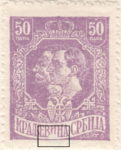 |
| 5 dinara | ||
| 1 | Frame below letter И in КРАЉЕВИНА broken. | 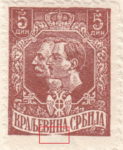 |
| COINCIDENTAL VARIETIES | ||
|---|---|---|
| 5 para | ||
| 1 | Overinking to the left. | 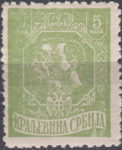 |
| 10 para | ||
| 1 | Double perforation horizontally. | 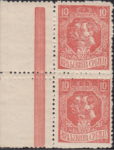 |
| 20 para | ||
| 1 | Vertically imperforate. | 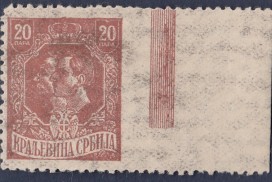 |
| 25 para | ||
| 1 | Double perforation horizontally. | 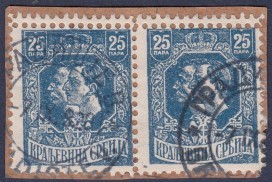 |
Postage Dues
1 April 1895. Postage dues, Royal Coat of Arms.
Printed in letterpress by Belgrade State Printers (Državna štamparija) on granite paper, perforation line 11½, the 5 para stamp also in comb 13 X 13½. Printed in sheets of 100 (10×10) with horizontal and vertical gutters (4 panes of 25 stamps).
| COINCIDENTAL VARIETIES | ||
|---|---|---|
| 1 | Wrong color: rose instead of red lilac. About 10 sheets of 5 para stamps were printed in color of 50 para stamp. They were not issued, used copies have favor cancels. | 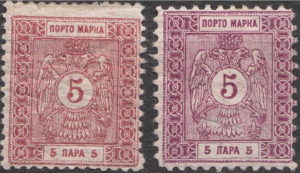 |
20 August 1898/1904. Postage dues, Royal Coat of Arms.
Printed in letterpress by Belgrade State Printers (Državna štamparija) on ordinary white paper, perforation line 11½. Printed in sheets of 100 (10×10) with horizontal and vertical gutters (4 panes of 25 stamps).
| COINCIDENTAL VARIETIES | ||
|---|---|---|
| 1 | By error an inverted cliche was inserted at the 98th field of 20 para sheet. | 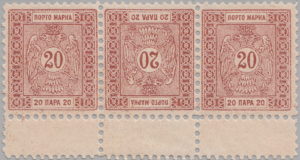 |
References
Bibliography
- Kardosh, Dr. Velizar M., The Principality of Serbia: postal History and Postage Stamps (1830-1882). ISBN 3-9521083-1-6.
- Katalog poštanskih maraka jugoslovenskih zemalja (1991), Jugomarka (Belgrade). YU ISSN 0351-4447
- Rasic R., Mirko (1979): The Postal History and Postage Stamps of Serbia. The Collectors Club Handbook No. 25, published by The Theodore E. Steinway Memorial Publication Fund. ISBN 0-912574-25-9.
Contributors
Some of the images on this page were contributed by:
- Mr. Predrag Simić, link

